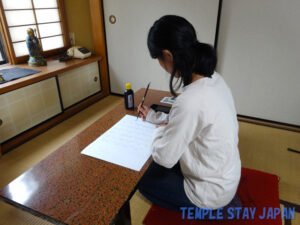Shukubo (shrine stay)
Komiya-Ryokan is a shukubo of Oyama Afuri Shrine. It was founded over 400 years ago and has hosted many worshippers.
It is located halfway up a slope called Tofuzaka, just off the main road that runs through the town of Oyama. This slope got its name from the fact that people who came to pray would eat tofu (soybean curd) while holding it in the palm of their hands.
The owner is a Shinto priest, and there is a altar inside the lodging.
Speciality tofu dishes
Mt. Oyama has been a sacred place for Shugendo since ancient times. Tofu is a valuable protein in traditional Buddhist cuisine that does not use meat or fish. It then began to be served to worshippers at shukubo, and the food developed.
At Komiya-Ryokan, we enjoyed creative tofu dishes made by the owner and his wife. The aperitif is homemade yuzu liquor. First, we had soy pulp and smoked salmon wrapped in tofu pickled in miso.
While heating soy milk in a pot, I added nigari (a kind of coagulant) and after a short time it solidified into tofu. I ate it with soy sauce and salt, and the sweetness of the tofu spread throughout my mouth.
The food is mainly Japanese, but I also had tofu lasagna. The habanero sauce adds a spicy and aromatic flavour. It went well with the local Isehara sake.
Other dishes served included sesame tofu, steamed tofu, deep-fried tofu, sashimi, salmon, chestnut rice, miso soup, and pickles.
The dessert is soy milk mousse. It was topped with persimmons and chestnuts from Mt. Oyama, and was so sweet that it made me happy.
The next morning, we had hot tofu for breakfast. The broth is made with kelp and then the dish is served with mizuna, Chinese cabbage, green onions, shiitake mushrooms, enoki mushrooms, etc.
Other dishes included rice, miso soup, grilled salmon, hijiki seaweed, spinach dressed in sesame seeds, tamagoyaki (egg roll), kamaboko (fish cake), nori seaweed, and pickles.
Guest room and bath
We stayed in an 8 tatami mat Japanese room. There were also other bedrooms provided. There was a TV, a safe and air conditioning. Yukata, towels, bath towels, and toothbrushes were provided.
I could hear the sound of the river flowing, it was like natural healing music.
The bath is large enough for 3-4 people to enter. We had the baths to ourselves, so we were able to relax and enjoy them.
Ita maneki (Historic signboard)
The owner told me when I checked out that there are “Ita maneki” hanging under the eaves.
There are many shukubo in the town of Oyama. For this reason, it seems that this sign was used as a mark for guests staying at the hotel in the past.
Each board has the name of a place written on it. In the past, people would stay at shukubo that had the name of the town they lived in written on them.









